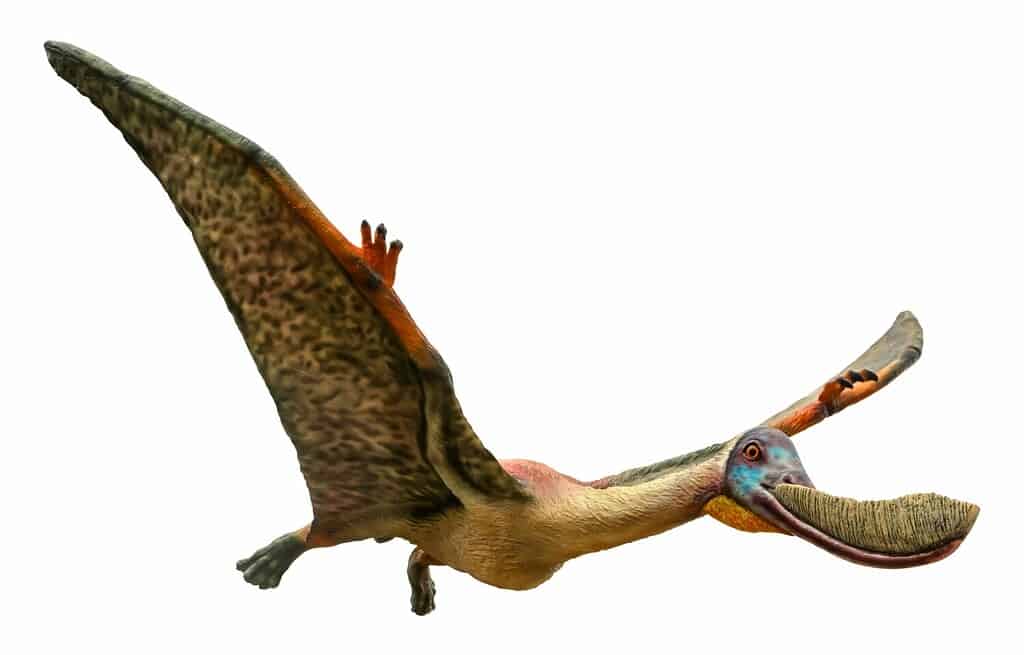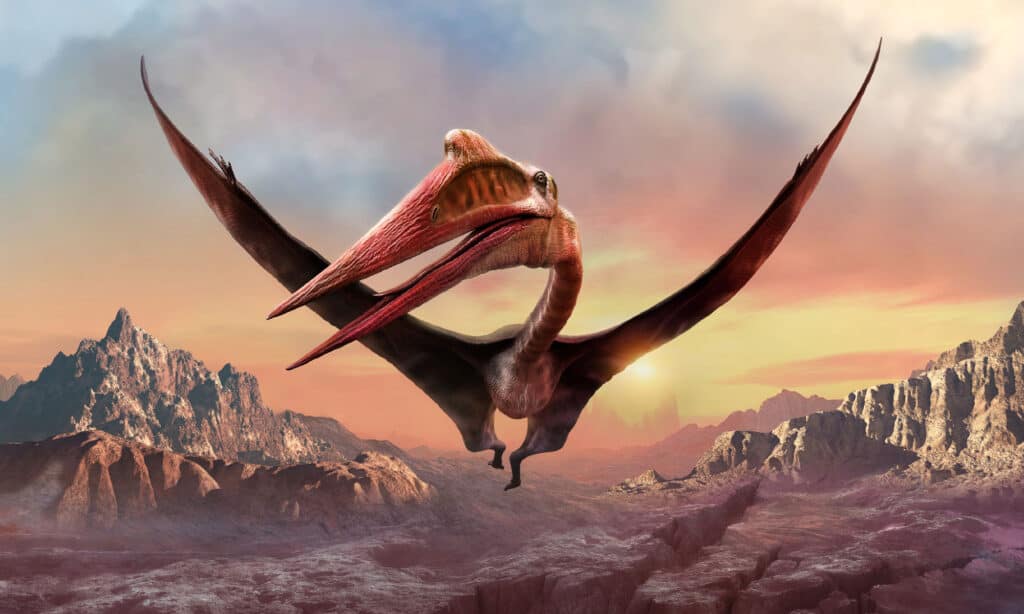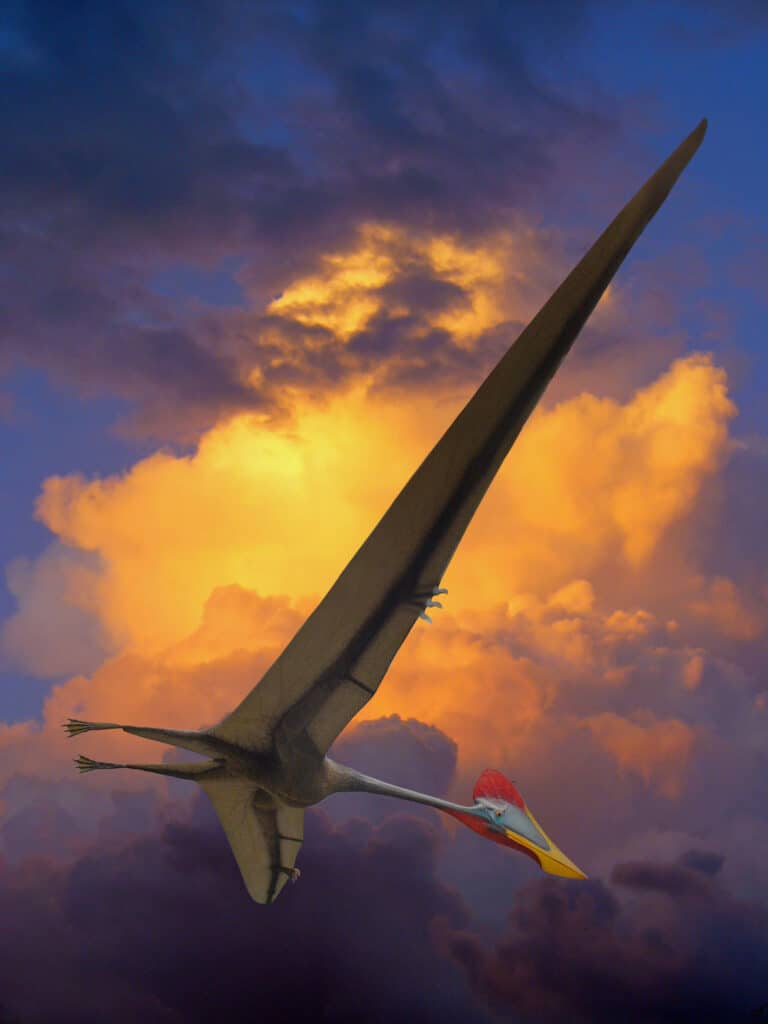Of all the things that fascinate dinosaur lovers, perhaps nothing fascinates like the giant flying reptiles known as Pterosaurs. From the exaggerated fictional kaiju Rodan to the more realistic versions in the Jurassic Park movies, there’s just something monstrous and fantastic about them. They came in various sizes, which makes one wonder, what was the largest Pterosaur?
Pterosaurs
Among the first vertebrates to attain active flight, Pterosaurs (Greek for “wing lizard“) had a common ancestry with dinosaurs, though they were not dinosaurs. They both came from a group called Avemetatarsalia. Now extinct, these flying reptiles took to the skies in the Mesozoic Era, playing their part from about 228 to 66 million years ago. The wings of pterosaurs were formed by skin, muscle, and other tissue creating a membrane from a lengthened finger to the body, unlike bats which stretch to a tail.

Pterosaurs were flying reptiles that existed in the Mesozoic Era. Which Pterosaur was the largest?
©YuRi Photolife/Shutterstock.com
Limited Fossil Record
Apart from deciding how to compare the size of Pterosaurs, there is also the difficulty of finding enough fossils to determine what typical sizes were for each species. There is a shortage of complete fossil remains available for many species. For example, Quetzalcoatlus northropi fossils are difficult to find, so the skull has been modeled on the smaller Q. lawsoni. Another competitor for the largest Pterosaur is Arambourgiania, and only two fossils of that species have been found so far.

When determining which Pterosaur was the largest, it is crucial to consider the available fossil record of each species.
©Steven U. Vidovic, David M. Martill, Matthew Martyniuk,, CC BY-SA 3.0, via Wikimedia Commons – License
What Was The Largest Pterosaur?
How do we determine which Pterosaur was the largest? Ratios of height to wingspan vary from species to species. Since we’re talking about winged reptiles, let’s focus on wingspan. That brings us to the next issue—the fossil record. If an alien civilization were to come to Earth after our demise and find the fossilized remains of an NBA center, they might conclude that the average height of a human male was 6’10. So it’s important to have many fossils of a species to determine its average characteristics. This is the problem that we have with many Pterosaur fossils.
Quetzalcoatlus has the most complete fossil remains of the largest Pterosaurs, including parts of a wing. Wingspan estimates of Hatzegopteryx and Arambourgiania were made based on neck vertebrae, humeri, femurs, and a variety of other smaller bones from incomplete fossils.
Estimates of Quetzalcoatlus’ wingspan have lately settled at 33 to 36 feet, coming down from initial estimates of 52 feet. Hatzegopteryx initially had an estimated wingspan of 33 to 39 feet. Still, some paleontologists have concluded that it is more likely to have a similar wingspan to Quetzalcoatlus. However, projections based on vertebrae alone are unreliable. Initial projections of Arambourgiana suggested a wingspan as great as 43 feet. Reevaluation, however, has placed it more in the range of 26 to 30 feet.
Though there are competitors for Quetzalcoatlus’ title of largest Pterosaur, it has the more complete fossil record, and much is unknown about the others. For now, Quetzalcoatlus is king.

Quetzalcoatlus was probably the largest animal with wings to exist.
©iStock.com/Warpaintcobra
Discovery
Discovered in 1971 by Douglas A. Lawson, a graduate geology student at the University of Texas, the first fossils (parts of a partial wing) were found at Big Bend National Park. The fossils were thought to come from a specimen with a 33-foot wingspan. Lawson found additional fossils from smaller specimens at a nearby site between 1972 and 1974. In a publication the following year, he declared that it was a new species. He named it after the feathered serpent god of the Aztecs (Quetzalcoatl) and the founder of the Northrop Corporation (an aviation firm.)
A Description of Quetzalcoatlus
It was first estimated that Quetzalcoatlus northropi had a wingspan of 52 feet. That estimate was later revised to 36-39 feet. More recent estimates place the wingspan at 33-36 feet. Its shoulder height is estimated to be 9.8 feet when standing. No species exist with similar proportions or features, so weight estimates vary quite a bit, from a low of 200 pounds to 500 pounds. Its bones would have been hollow to reduce weight. Since the larger remains were found without a skull, the smaller version, Q. lawsoni (named after the geologist who made the first discovery), has served as a model. It is believed that Q. northropi had a long, pointed beak and a crest on the top of the skull.

The
Quetzalcoatlus northropiis one of the largest flying animals to have ever existed. It lived on Earth about 144 to 67 million years ago.
©Johnson Mortimer, CC BY 3.0, via Wikimedia Commons – License
Quetzalcoatlus’ Diet
It was thought, at first, that Q. northropi fed by skimming water surfaces for prey. Recent studies, though, have determined that not to be the case. It is now thought that Quetzalcoatlus’ limbs were more suited to moving on land and that its beak was not suited to skimming. It is believed that Q. northropi foraged for small game and carrion, as a stork would.
How Did Quetzalcoatlus Fly?
How could an animal as large as Quetzalcoatlus ever fly? Paleontologists have concluded that Quetzalcoatlus’ large breastbone would have provided enough support for the powerful muscles required of such size. They also believe that its legs were strong enough to launch it up to 8 feet in the air, where it would have enough space to beat its massive wings. It is also thought that they could fly incredible distances.

Quetzalcoatlus northropi was the largest member of the Quetzalcoatlus genus.
©Model created by René Kastner, Staatliches Museum für Naturkunde Karlsruhe, Germany. Foto: H. Zell, CC BY-SA 3.0, via Wikimedia Commons – License
Conclusion
As mentioned in the introduction, Quetxalcoatlus has captured the public’s imagination with its status as the largest Pterosaur known to date. Until more evidence can be found in the fossil record regarding other Pterosaurs, Quetzalcoatlus will remain number one.
The photo featured at the top of this post is © kamomeen/Shutterstock.com
Thank you for reading! Have some feedback for us? Contact the AZ Animals editorial team.






